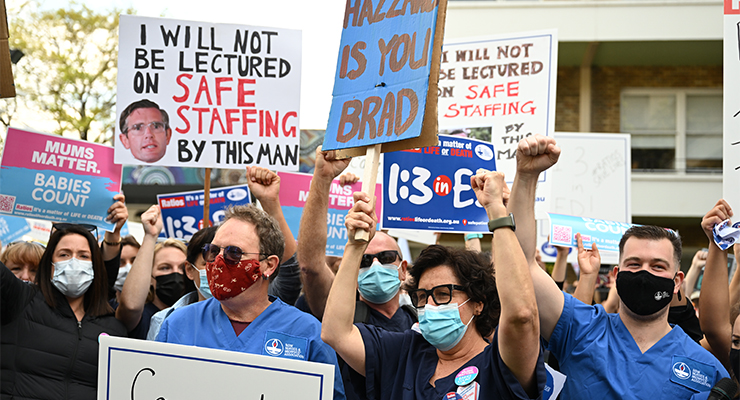
Reflecting the essentially theatrical nature of yesterday’s first day of the jobs summit, the government didn’t even wait for the lunch break before deciding that the ACTU’s push for a restoration of multi-employer and even sector bargaining would be legislated — details to be determined.
At The Australian Financial Review, where workers are seen as malignant Lilliputians restraining the glorious Gullivers of the management class, there’s apoplexy. Employer groups are furious. Innes Willox of the Australian Industry Group warned of “a new front for disruptive and costly industrial action, potentially across a sector or broad parts of the economy”.
To which the answer is: so be it.
Most of the debate about increasing wages growth in Australia has occurred in a fantasy world. The fantasy — peddled by the Reserve Bank and Treasury for the past few years — that wages growth would pick up in just a couple of quarters’ time. The fantasy, peddled by business and its media cheerleaders and now embraced by the government, that if only we could lift productivity, wages would follow.
In fact wages stagnation has reflected the power balance between workers and corporations, a balance that has tipped further and further in favour of the latter for decades, enabling them to keep all the benefits of labour productivity growth and drive up the profit share of national income to the detriment of workers. Hell, even Tony Boyd at the AFR recognises that.
The other fantasy element is the idea — another one pushed by the government — that wages growth would improve if business and unions could get together and agree rather than constantly sparring with each other.
No business is going to hand over higher wage rises because peak bodies are writing communiqués in Canberra. Consensus won’t drive better pay outcomes. Only shifting the power balance in favour of workers, and allowing workers to use that greater power to force better wage deals, will lift wages growth. Higher pay will have to be fought for, wrung from reluctant, even hostile, employers, gained by industrial action taken against corporations that for years now have exploited their power over workers to suppress wages.
They’re not going to give that up without a fight.
This means more strikes. Well, it means strikes — because we hardly have them anymore. We have a long, long, long way to go before we return to Willox’s nightmare of a return to the 1980s.

How many more strikes? Maybe we can lift them if we returned to levels of a decade ago, when wages growth was last in the high threes? Strikes averaged seven days lost per 100 employees in 2012. Or 2003, when wages were also growing in the high threes, when days lost averaged 14, under the Coalition’s workplace bargaining laws.
Australian employers have persistently demonstrated they will do anything other than pay higher wages. Even when they’re desperate for workers, they’ll just offer bonuses, not permanent raises. Or they’ll scream to be allowed to bring in more temporary migrants. And they’ll engage in systemic wage theft.
The idea that, out of some abundance of good will, they’ll suddenly start handing over substantial wage rises is a fantasy. Higher wages mean putting strikes back into the industrial relations toolkit. And with sector-wide bargaining, workers will have more power to organise collectively to secure those higher wages. Bring it on.
Do you think industrial action is important? Let us know by writing to letters@crikey.com.au. Please include your full name to be considered for publication. We reserve the right to edit for length and clarity.








Go, Keane. I’ve been in a union that tried bargaining with employers, and several unions that made demands followed by action. The nice, well-intended union did not get me the same benefits as the surly ones.
If even a dearth of workers can’t get businesses to pay up, then maybe we need strikes to come back.
We clearly have a problem in society now in terms of paying workers, and it’s clear that businesses will only be happy when we return to serfdom. Any bloviating from those on the business side is a waste of energy for all concerned and it really really sucks that it is the standard of debate we accept on this issue.
“Business AS USUAL says sector bargaining will lead to more strikes. So be it.”
There, fixed the headline for you
A worker without the ability to strike is like a country without an army.
You need the ability to do damage to be taken seriously by difficult people.
Power is never willingly surrendered – it has to be taken/seized.